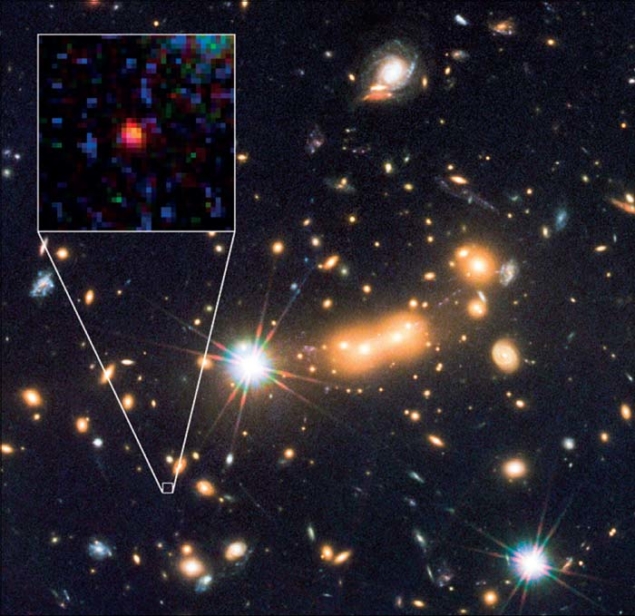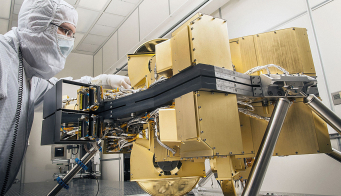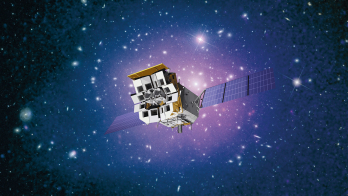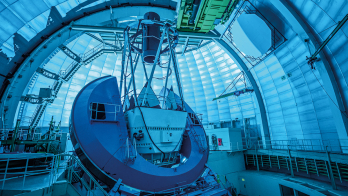
Image credit: NASA, ESA, M Postman and D Coe of STScI and the CLASH team.
Although the Hubble Space Telescope is more than 22 years old, the regular upgrade of its instruments preserves intact its discovery potential as time goes by. Now, its quest to detect the most distant and therefore earliest galaxies in the universe is reaching new frontiers with two candidates at a redshift of around 11. One of them was found in the Hubble Ultra Deep Field, the other using the light amplification of gravitational lensing induced by a cluster of galaxies.
Of all of the scientific satellites, Hubble is the only one that can be upgraded by astronauts. The fourth and final servicing mission was conducted in May 2009 with the space shuttle Atlantis. One of the two new instruments installed was the Wide Field Camera 3 (WFC3), which offers a large field of view and broad wavelength-coverage from ultraviolet to infrared light. These characteristics make it an ideal instrument to find rare and extremely distant galaxies.
Identifying such galaxies requires looking for as long as possible in an apparently empty patch of the sky and searching for the faintest spots of light that show up in the infrared image while being absent in the visible range. A remote galaxy will be observed only in the infrared because the wavelength of its visible radiation has been stretched on its journey by the expansion of the universe. This redshift, z, is a direct measurement of the cosmological distance of a galaxy and it can be determined accurately by measuring the shift of well identified spectral lines. Such a spectroscopic determination is out of reach for current instrumentation because the galaxies are too faint. A less robust alternative is to integrate the light in a series of spectral bands with various filters and to locate the bands on each side of the “Lyman break” – a sharp feature that results from the absorption of light by neutral hydrogen in a star-forming galaxy at wavelengths below 91.2 nm, corresponding to the energy (13.6 eV) needed to ionize the atom.
A team of scientists co-led by Richard Ellis of Caltech and Ross McLure of the University of Edinburgh has made new observations of the Hubble Ultra Deep Field (CERN Courier November 2012 p15). The study used one additional filter and undertook much deeper exposures in some filters to improve the reliability of high-redshift determinations. The team identified seven galaxies at redshifts above 8.5 that would represent a previously unseen population of galaxies that formed more than 13 thousand million years ago, when the universe was only about 3–4% of its current age. One of the galaxies, designated UDFj-39546284, was already a candidate for the highest redshift (z around 10) two years ago (CERN Courier March 2011 p10). The new observations suggest that it is even further away, at z = 11.9, unless it is an intense emission-line galaxy at z around 2.4. The latter possibility can only be ruled out with a deep infrared spectrum of the kind that the James Webb Space Telescope will provide after its planned in 2018.
Another team, led by Dan Coe of the Space Telescope Science Institute (STScI) in Baltimore, is using a different approach. They look for high-redshift objects around 25 clusters of galaxies observed by Hubble. The clusters are used as magnifying glasses that have the potential to amplify the light of background galaxies by a large factor, thanks to strong gravitational lensing (CERN Courier April 2008 p11). The latest discovery is a galaxy, known as MACS0647-JD, with a redshift of 10.8 ± 0.5. It seems to be a tiny galaxy with a mass not exceeding 1% of the mass of the Milky Way and could be one of many building blocks of a spiral galaxy like ours.







